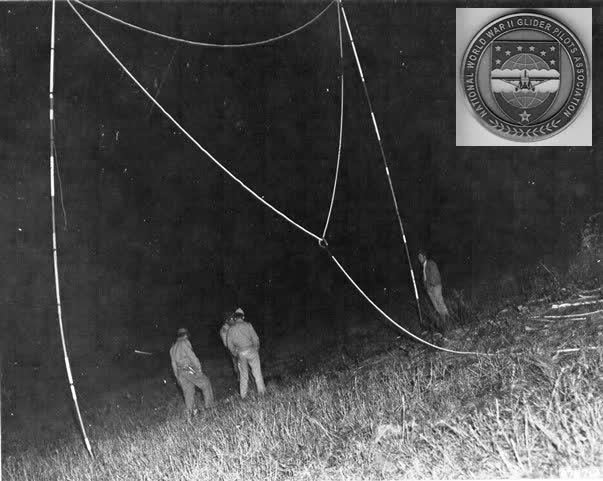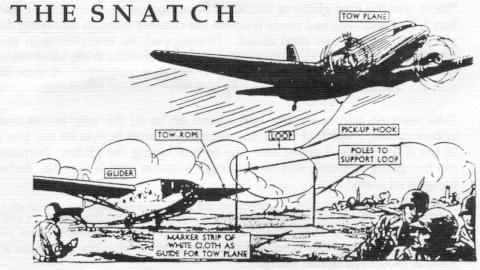National WWII Glider Pilots AssociationLegacy Organization of veterans National WWII Glider Pilots Association. Discover our History, Preserve our Legacy | ||
|
Snatching a big troop/cargo glider from the ground by an airplane on the fly during daylight hours is pretty heady stuff, but envisions that same scenario occurring at night. That’s exactly what happened on a February night in Burma in 1944. British General Bernard Ferguson’s Black Watch Regiment needed to cross the Chindwin River in Burma on a covert mission, so he called on the American 1st Air Commando Group to deliver inflatable rubber boats by glider. Colonel Phil Cochran, head of the group, responded by dispatching two CG-4A gliders with the boats that landed on a sandbar on the Chindwin River as specified by General Ferguson. The gliders were flown by Flight Officers J. S. “Mickey” Bartlett and Vernon “Needle Nose” Noland. Bartlett’s glider was damaged on landing and was not retrievable. By the time the two pilots could set up the ground station poles and attach the looped retrieval rope it had turned dark. Noland radioed Captain Richard Cole, the pilot of the C-47 that remained circling overhead, and explained that he would mount flashlights on the retrieval poles. To further orient Cole, he would mount a third flashlight on a pole forward of the two poles in a straight line. This would insure the correct direction of approach. With precision the tow pilot hooked the rope loop and snatched the glider on the first try. In 5.6 seconds the stationary glider went from zero to 120 mph, but the jolt was less than that of a Navy aircraft being catapulted off the deck of an aircraft carrier. The glider cargo was two Japanese officers who had been captured by General Ferguson’s regiment that were being taken to Wingate’s headquarters for interrogation. This is only known night glider retrieval in a combat area. The described “flashlights” were not ordinary “C” cell flashlights as were available then and as we think of today. Mention is made of them being powered by a large external battery as was done for the Ondal developed system. These likely were 12 volt “automobile” type lead acid batteries of the time. This means the white lights were not ordinary flashlights taped to the tops of the poles. mmandos in the CBI Theater prior to the Chindwin River retrieval. Glider pilot Lt Robert Sharrock, who later was killed in action, developed and worked on special equipment to make night glider retrieval possible. This work was done at Ondal India. Several other men helped Sharrock part time. Warrant Officer Evans, M/Sgt Rumpfelt, glider pilots Lt Neil Blush, F/O Edwin Lavarre and F/O James Bartlett helped set up the equipment and make “dry-runs” to check out the system. The night system was basically the same as the USAAF system developed for daylight pick-up with these exceptions; the partially wood and steel tubing poles that supported the nylon loop were twenty-four feet tall instead of twelve feet tall. The poles were set twenty-eight feet apart rather than twenty feet apart. The rest of the system was two white lights and four red lights powered by four 12-volt lead acid batteries separately connected to each light set. The batteries would power the lights continuously for six hours. The red and white lights were positioned to help the tug pilot see the poles and judge his height above the ground, to accomplish the pick-up. Each of the twenty-four foot tall poles had a white light at the top. A straight horizontal line was established, 90 degrees vertical to the two poles and nineteen feet to the right of the left pole (this offset compensated for the offset of the pick-up arm mounted on the port side of the C-47). One red light was set on this line, on the ground, three hundred feet in front of the 24 foot poles. On this horizontal line thirty-five feet to the rear of the two poles was set a red light on a nineteen foot tall pole. Continuing five hundred feet (535 feet from the two poles) from this red light, centered on the same horizontal line, two red lights were placed on the ground 38 feet apart. As evidenced by the photograph, the pickup loop and line were not changed, only the support poles were longer to further raise the loop contact area above the ground. 
1AC night photo, 24 foot tall pickup poles w/standard pickup line loop. Four men would be four of those previously listed. On January 2, 1944, using this system, glider pilot F/O Kenneth Johnson piloted a CG-4A in the first night CG-4A pick-up at Panagarh India. Further research will have to determine where, when and how many night pickups were performed and who were the C-47 tug pilots and the glider pilots who flew those night pickups.
---------------------------- REFERENCES:
|
BURMA
Awards THURSDAY
Awards CHOWRINGHEE
Special Briefing Edition:
80th Commemeration 2024
Operation Thursday
75th Anniversary
Operation Thursday
Burma Compalation of Info.
The Beginning of Special Operations
Birth of the Air Commandos
Flight Officer Shimulunas
First Published in Briefing 2020
Locating FO Robert Charles Hall
First Published in Briefing 2021
Flight Officer John (Jackie) L. Coogan
First Published in Briefing 2022
Mules in Gliders
First published in Substack
Glider Retrieval:
Glider Retrieval by Jungle Moonlight
Randal Baily interviews Glider Pilot Tim Baily about Liberating Prisoners of Pergu, Burma “Jungle Rescue” glider snatch.

Used effectively in Burma! After unloading equipment loaded up with stretcher and walking wounded and then snatched out. Returned to Hospital in about 2 hours as opposed to two months by ambulance.

Setting out the tow ropes to hook up the gliders.









